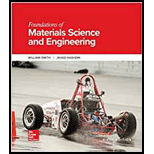
Concept explainers
A unidirectional carbon fiber–epoxy resin composite contains 68% by volume of carbon fiber and 32% epoxy resin. The density of the carbon fiber is 1.79 g/cm3 and that of the epoxy resin is 1.20 g/cm3. (a) What are the weight percentages of carbon fibers and epoxy resin in the composite? (b) What is the average density of the composite?
(a)
The weight percentage of carbon fibers in the composite.
The weight percentage of epoxy resin in the composite.
Answer to Problem 40AAP
The weight percentage of carbon fibers in the composite is
The weight percentage of epoxy resin in the composite is
Explanation of Solution
Write the expression to calculate mass of carbon fiber in the composite
Here, density of carbon fiber is
Write the expression to calculate mass of epoxy resin in the composite
Here, density of epoxy resin is
Write the expression to calculate total mass of the composite
Here, density of epoxy resin is
Write the expression to calculate weight percentage of carbon fiber in the composite
Write the expression to calculate weight percentage of epoxy resin in the composite
Conclusion:
Substitute
Substitute
Substitute
Substitute
Substitute
Thus, the weight percentage of carbon fibers in the composite is
(b)
The average density of the composite.
Answer to Problem 40AAP
The average density of the composite is
Explanation of Solution
Write the expression to calculate average density of the composite
Here, total volume of composite is
Conclusion:
Substitute
Thus, the average density of the composite is
Want to see more full solutions like this?
Chapter 12 Solutions
FOUND.OF MTRLS.SCI+ENGR.(LL)-W/CONNECT
- Boron coated with SiC reinforced aluminum containing 40 vol.% fibers is animportant high temperature, light weight composite material. Estimate the density, modulus of elasticity, and tensile strength of composite parallel to the fiber axis. Also estimate the modulus of elasticity of composite perpendicular to the fibres.arrow_forwardBoron coated with SiC reinforced aluminium containing 40 vol.% fibers is animportant high temperature, light weight composite material. Estimate the density,modulus of elasticity and tensile strength of composite parallel to the fiber axis. Alsoestimate the modulus of elasticity of composite perpendicular to the fibres.arrow_forward27e) What are called composite ? What are the constituents of composites? How are composite materials classified? What is the role of matrix material and base material in a composite?arrow_forward
- When answering the following questions , ensure that you explain in terms of both the microscopic and macroscopic structure of the materials. A) polymer - explain the difference in structure between a thermoplastic and thermoset material and explain how the structure accounts for the key generic properties of those polymers. B) composite material - for a particular composite and a fibre reinforce composite , explain the difference in structure and whst structual features dictate the properties of the material.arrow_forwardOriginal question: The nominal engineering constants of a unidirectional graphite epoxy ply are given in Table below for a fiber volume fraction of 60 percent. The fiber volume is reduced to 55 percent. Estimate the engineering constants for this reduced fiber volume fraction. New question needing to be answered: Repeat with a reduced fiber volume fraction of 40 percent representative of lower fiber volume fraction materials. Table:arrow_forwardWhat is the distinction between matrix and dispersed phases in a composite material? Contrast the mechanical characteristics of matrix and dispersed phases for fiber reinforced composites.arrow_forward
- For a given polymer, the activation energy for stress relaxation was measured to be 10 kJ/mol. If the stress relaxation time for this polymer at room temperature is 3,600 s, what would be the relaxation time at 100 ◦C?arrow_forwarda) List down the four molecular structures for polymers. Discuss in detail how the four molecular structures affect the level of strength of the resulting polymers according to their order. b) Define composites. Describe the phase present in composites. With time,the use of composite in aircraft body has increased to 50% discuss the advantages of composites as compared to conventional materials in aerospace industry c) List down one processing method for production of composite tubes made of fiber reinforced polymer.Briefly describe the processing steps involved.arrow_forwardA reinforced plastic sheet is to be made of a matrix with a tensile strength of 60MN/m^2 and a continuous glass fibre with a modulus of 76GN/m^2.If the resin ratio by volume is 70% and the modular ratio of the composite is 25, estimate the tensile strength and modulus of the composite.arrow_forward
- Note: Read the question carefully and give me right solution according to the question. List three main classification of engineering Fibre-reinforced composites. Name one example of both the dispersed phase material and matrix phase material for each classification.arrow_forwardCan anyone please explain? This is all that is given. TIA... Determine the % weight savings that would occur if a steel drive shaft were replaced with a carbon/epoxy drive shaft. The carbon/epoxy composite is 60% carbon fibers (density=1.80 g/cc). Assume the volume of the drive shaft is the same for both the steel and the composite drive shaft.arrow_forwardWhy do thermoplastic polymers start to turn white as they are plastically deformed?arrow_forward
 Elements Of ElectromagneticsMechanical EngineeringISBN:9780190698614Author:Sadiku, Matthew N. O.Publisher:Oxford University Press
Elements Of ElectromagneticsMechanical EngineeringISBN:9780190698614Author:Sadiku, Matthew N. O.Publisher:Oxford University Press Mechanics of Materials (10th Edition)Mechanical EngineeringISBN:9780134319650Author:Russell C. HibbelerPublisher:PEARSON
Mechanics of Materials (10th Edition)Mechanical EngineeringISBN:9780134319650Author:Russell C. HibbelerPublisher:PEARSON Thermodynamics: An Engineering ApproachMechanical EngineeringISBN:9781259822674Author:Yunus A. Cengel Dr., Michael A. BolesPublisher:McGraw-Hill Education
Thermodynamics: An Engineering ApproachMechanical EngineeringISBN:9781259822674Author:Yunus A. Cengel Dr., Michael A. BolesPublisher:McGraw-Hill Education Control Systems EngineeringMechanical EngineeringISBN:9781118170519Author:Norman S. NisePublisher:WILEY
Control Systems EngineeringMechanical EngineeringISBN:9781118170519Author:Norman S. NisePublisher:WILEY Mechanics of Materials (MindTap Course List)Mechanical EngineeringISBN:9781337093347Author:Barry J. Goodno, James M. GerePublisher:Cengage Learning
Mechanics of Materials (MindTap Course List)Mechanical EngineeringISBN:9781337093347Author:Barry J. Goodno, James M. GerePublisher:Cengage Learning Engineering Mechanics: StaticsMechanical EngineeringISBN:9781118807330Author:James L. Meriam, L. G. Kraige, J. N. BoltonPublisher:WILEY
Engineering Mechanics: StaticsMechanical EngineeringISBN:9781118807330Author:James L. Meriam, L. G. Kraige, J. N. BoltonPublisher:WILEY





